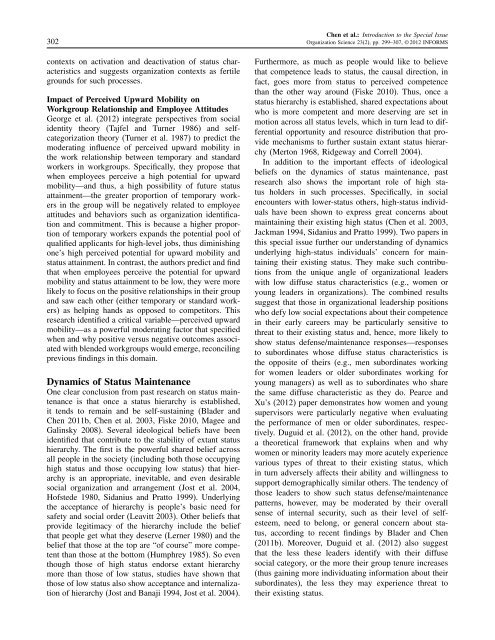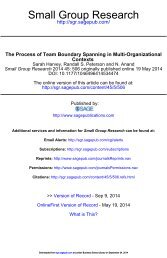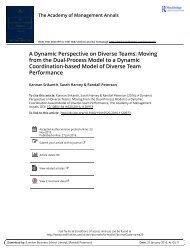Introduction to the Special Issue: Bringing Status to the Table—Attaining, Maintaining, and Experiencing Status in Organizations and Markets
Create successful ePaper yourself
Turn your PDF publications into a flip-book with our unique Google optimized e-Paper software.
Chen et al.: <strong>Introduction</strong> <strong>to</strong> <strong>the</strong> <strong>Special</strong> <strong>Issue</strong><br />
302 Organization Science 23(2), pp. 299–307, © 2012 INFORMS<br />
contexts on activation <strong>and</strong> deactivation of status characteristics<br />
<strong>and</strong> suggests organization contexts as fertile<br />
grounds for such processes.<br />
Impact of Perceived Upward Mobility on<br />
Workgroup Relationship <strong>and</strong> Employee Attitudes<br />
George et al. (2012) <strong>in</strong>tegrate perspectives from social<br />
identity <strong>the</strong>ory (Tajfel <strong>and</strong> Turner 1986) <strong>and</strong> selfcategorization<br />
<strong>the</strong>ory (Turner et al. 1987) <strong>to</strong> predict <strong>the</strong><br />
moderat<strong>in</strong>g <strong>in</strong>fluence of perceived upward mobility <strong>in</strong><br />
<strong>the</strong> work relationship between temporary <strong>and</strong> st<strong>and</strong>ard<br />
workers <strong>in</strong> workgroups. Specifically, <strong>the</strong>y propose that<br />
when employees perceive a high potential for upward<br />
mobility—<strong>and</strong> thus, a high possibility of future status<br />
atta<strong>in</strong>ment—<strong>the</strong> greater proportion of temporary workers<br />
<strong>in</strong> <strong>the</strong> group will be negatively related <strong>to</strong> employee<br />
attitudes <strong>and</strong> behaviors such as organization identification<br />
<strong>and</strong> commitment. This is because a higher proportion<br />
of temporary workers exp<strong>and</strong>s <strong>the</strong> potential pool of<br />
qualified applicants for high-level jobs, thus dim<strong>in</strong>ish<strong>in</strong>g<br />
one’s high perceived potential for upward mobility <strong>and</strong><br />
status atta<strong>in</strong>ment. In contrast, <strong>the</strong> authors predict <strong>and</strong> f<strong>in</strong>d<br />
that when employees perceive <strong>the</strong> potential for upward<br />
mobility <strong>and</strong> status atta<strong>in</strong>ment <strong>to</strong> be low, <strong>the</strong>y were more<br />
likely <strong>to</strong> focus on <strong>the</strong> positive relationships <strong>in</strong> <strong>the</strong>ir group<br />
<strong>and</strong> saw each o<strong>the</strong>r (ei<strong>the</strong>r temporary or st<strong>and</strong>ard workers)<br />
as help<strong>in</strong>g h<strong>and</strong>s as opposed <strong>to</strong> competi<strong>to</strong>rs. This<br />
research identified a critical variable—perceived upward<br />
mobility—as a powerful moderat<strong>in</strong>g fac<strong>to</strong>r that specified<br />
when <strong>and</strong> why positive versus negative outcomes associated<br />
with blended workgroups would emerge, reconcil<strong>in</strong>g<br />
previous f<strong>in</strong>d<strong>in</strong>gs <strong>in</strong> this doma<strong>in</strong>.<br />
Dynamics of <strong>Status</strong> Ma<strong>in</strong>tenance<br />
One clear conclusion from past research on status ma<strong>in</strong>tenance<br />
is that once a status hierarchy is established,<br />
it tends <strong>to</strong> rema<strong>in</strong> <strong>and</strong> be self-susta<strong>in</strong><strong>in</strong>g (Blader <strong>and</strong><br />
Chen 2011b, Chen et al. 2003, Fiske 2010, Magee <strong>and</strong><br />
Gal<strong>in</strong>sky 2008). Several ideological beliefs have been<br />
identified that contribute <strong>to</strong> <strong>the</strong> stability of extant status<br />
hierarchy. The first is <strong>the</strong> powerful shared belief across<br />
all people <strong>in</strong> <strong>the</strong> society (<strong>in</strong>clud<strong>in</strong>g both those occupy<strong>in</strong>g<br />
high status <strong>and</strong> those occupy<strong>in</strong>g low status) that hierarchy<br />
is an appropriate, <strong>in</strong>evitable, <strong>and</strong> even desirable<br />
social organization <strong>and</strong> arrangement (Jost et al. 2004,<br />
Hofstede 1980, Sidanius <strong>and</strong> Prat<strong>to</strong> 1999). Underly<strong>in</strong>g<br />
<strong>the</strong> acceptance of hierarchy is people’s basic need for<br />
safety <strong>and</strong> social order (Leavitt 2003). O<strong>the</strong>r beliefs that<br />
provide legitimacy of <strong>the</strong> hierarchy <strong>in</strong>clude <strong>the</strong> belief<br />
that people get what <strong>the</strong>y deserve (Lerner 1980) <strong>and</strong> <strong>the</strong><br />
belief that those at <strong>the</strong> <strong>to</strong>p are “of course” more competent<br />
than those at <strong>the</strong> bot<strong>to</strong>m (Humphrey 1985). So even<br />
though those of high status endorse extant hierarchy<br />
more than those of low status, studies have shown that<br />
those of low status also show acceptance <strong>and</strong> <strong>in</strong>ternalization<br />
of hierarchy (Jost <strong>and</strong> Banaji 1994, Jost et al. 2004).<br />
Fur<strong>the</strong>rmore, as much as people would like <strong>to</strong> believe<br />
that competence leads <strong>to</strong> status, <strong>the</strong> causal direction, <strong>in</strong><br />
fact, goes more from status <strong>to</strong> perceived competence<br />
than <strong>the</strong> o<strong>the</strong>r way around (Fiske 2010). Thus, once a<br />
status hierarchy is established, shared expectations about<br />
who is more competent <strong>and</strong> more deserv<strong>in</strong>g are set <strong>in</strong><br />
motion across all status levels, which <strong>in</strong> turn lead <strong>to</strong> differential<br />
opportunity <strong>and</strong> resource distribution that provide<br />
mechanisms <strong>to</strong> fur<strong>the</strong>r susta<strong>in</strong> extant status hierarchy<br />
(Mer<strong>to</strong>n 1968, Ridgeway <strong>and</strong> Correll 2004).<br />
In addition <strong>to</strong> <strong>the</strong> important effects of ideological<br />
beliefs on <strong>the</strong> dynamics of status ma<strong>in</strong>tenance, past<br />
research also shows <strong>the</strong> important role of high status<br />
holders <strong>in</strong> such processes. Specifically, <strong>in</strong> social<br />
encounters with lower-status o<strong>the</strong>rs, high-status <strong>in</strong>dividuals<br />
have been shown <strong>to</strong> express great concerns about<br />
ma<strong>in</strong>ta<strong>in</strong><strong>in</strong>g <strong>the</strong>ir exist<strong>in</strong>g high status (Chen et al. 2003,<br />
Jackman 1994, Sidanius <strong>and</strong> Prat<strong>to</strong> 1999). Two papers <strong>in</strong><br />
this special issue fur<strong>the</strong>r our underst<strong>and</strong><strong>in</strong>g of dynamics<br />
underly<strong>in</strong>g high-status <strong>in</strong>dividuals’ concern for ma<strong>in</strong>ta<strong>in</strong><strong>in</strong>g<br />
<strong>the</strong>ir exist<strong>in</strong>g status. They make such contributions<br />
from <strong>the</strong> unique angle of organizational leaders<br />
with low diffuse status characteristics (e.g., women or<br />
young leaders <strong>in</strong> organizations). The comb<strong>in</strong>ed results<br />
suggest that those <strong>in</strong> organizational leadership positions<br />
who defy low social expectations about <strong>the</strong>ir competence<br />
<strong>in</strong> <strong>the</strong>ir early careers may be particularly sensitive <strong>to</strong><br />
threat <strong>to</strong> <strong>the</strong>ir exist<strong>in</strong>g status <strong>and</strong>, hence, more likely <strong>to</strong><br />
show status defense/ma<strong>in</strong>tenance responses—responses<br />
<strong>to</strong> subord<strong>in</strong>ates whose diffuse status characteristics is<br />
<strong>the</strong> opposite of <strong>the</strong>irs (e.g., men subord<strong>in</strong>ates work<strong>in</strong>g<br />
for women leaders or older subord<strong>in</strong>ates work<strong>in</strong>g for<br />
young managers) as well as <strong>to</strong> subord<strong>in</strong>ates who share<br />
<strong>the</strong> same diffuse characteristic as <strong>the</strong>y do. Pearce <strong>and</strong><br />
Xu’s (2012) paper demonstrates how women <strong>and</strong> young<br />
supervisors were particularly negative when evaluat<strong>in</strong>g<br />
<strong>the</strong> performance of men or older subord<strong>in</strong>ates, respectively.<br />
Duguid et al. (2012), on <strong>the</strong> o<strong>the</strong>r h<strong>and</strong>, provide<br />
a <strong>the</strong>oretical framework that expla<strong>in</strong>s when <strong>and</strong> why<br />
women or m<strong>in</strong>ority leaders may more acutely experience<br />
various types of threat <strong>to</strong> <strong>the</strong>ir exist<strong>in</strong>g status, which<br />
<strong>in</strong> turn adversely affects <strong>the</strong>ir ability <strong>and</strong> will<strong>in</strong>gness <strong>to</strong><br />
support demographically similar o<strong>the</strong>rs. The tendency of<br />
those leaders <strong>to</strong> show such status defense/ma<strong>in</strong>tenance<br />
patterns, however, may be moderated by <strong>the</strong>ir overall<br />
sense of <strong>in</strong>ternal security, such as <strong>the</strong>ir level of selfesteem,<br />
need <strong>to</strong> belong, or general concern about status,<br />
accord<strong>in</strong>g <strong>to</strong> recent f<strong>in</strong>d<strong>in</strong>gs by Blader <strong>and</strong> Chen<br />
(2011b). Moreover, Duguid et al. (2012) also suggest<br />
that <strong>the</strong> less <strong>the</strong>se leaders identify with <strong>the</strong>ir diffuse<br />
social category, or <strong>the</strong> more <strong>the</strong>ir group tenure <strong>in</strong>creases<br />
(thus ga<strong>in</strong><strong>in</strong>g more <strong>in</strong>dividuat<strong>in</strong>g <strong>in</strong>formation about <strong>the</strong>ir<br />
subord<strong>in</strong>ates), <strong>the</strong> less <strong>the</strong>y may experience threat <strong>to</strong><br />
<strong>the</strong>ir exist<strong>in</strong>g status.
















